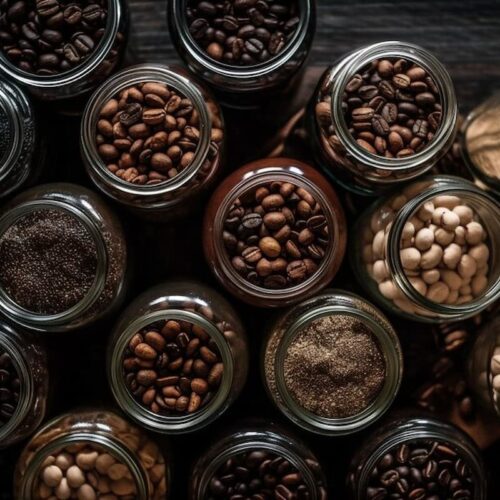Deep in the middle of the South Atlantic Ocean lies a small volcanic island called St. Helena. Despite its isolation, this island is home to one of the world’s rarest and most sought-after coffee beans.
St. Helena coffee is known for its unique flavor, rich history, and direct connection to Napoleon Bonaparte. But what makes this coffee so special?
In this article, we explore the fascinating story behind St. Helena coffee, its cultivation process, and why it remains one of the most exclusive coffees in the world.
The Origins of St. Helena Coffee
Location: St. Helena Island, South Atlantic Ocean
First Cultivation: Late 1700s
Bean Variety: Green Tipped Bourbon
St. Helena coffee traces its origins back to the late 18th century when the British East India Company introduced coffee plants to the island. The plants were believed to have originated from Yemen’s famous Mocha region, making them descendants of some of the earliest cultivated coffee beans in history.
The island’s volcanic soil, high altitude, and oceanic climate provided the perfect environment for these beans to thrive. Over time, St. Helena developed a unique coffee profile that blended the best characteristics of Yemeni coffee with the distinct terroir of the island.
Because of its remote location, the coffee grown on St. Helena remained relatively unknown for centuries. However, the few who had the chance to taste it recognized its superior quality and refined flavor.
Today, St. Helena coffee continues to be produced in small batches, maintaining its exclusivity and high demand among coffee connoisseurs.
Napoleon Bonaparte and His Love for St. Helena Coffee
One of the most intriguing aspects of St. Helena coffee is its connection to Napoleon Bonaparte.
After his defeat at the Battle of Waterloo in 1815, Napoleon was exiled to St. Helena, where he spent the last six years of his life.
During his time on the island, Napoleon developed a deep appreciation for the local coffee. Historical records indicate that he preferred St. Helena coffee over all others, describing it as “the only good thing about this island.”
His endorsement played a crucial role in popularizing the coffee, especially among European aristocrats. Wealthy coffee enthusiasts sought after St. Helena coffee, willing to pay high prices for its rarity and smooth taste.
Even after Napoleon’s death in 1821, the legend of St. Helena coffee continued to grow. Today, it is still considered one of the finest and rarest coffees in the world.
What Makes St. Helena Coffee So Unique?
Several factors contribute to the uniqueness of St. Helena coffee, making it different from any other coffee variety:
- Single-Origin Purity: Unlike many coffees that are blended with beans from different regions, St. Helena coffee is strictly single-origin, meaning every bean comes from the island.
- Exclusive Green Tipped Bourbon Variety: The beans grown in St. Helena are a rare mutation of Bourbon coffee, known for their floral and citrusy notes.
- Slow Maturation Process: Due to the island’s cool oceanic climate, coffee plants grow at a slower rate, allowing flavors to develop more intensely.
- Natural Processing: St. Helena coffee is traditionally sun-dried and hand-processed, preserving its delicate flavors.
These characteristics result in a coffee that is incredibly smooth, with bright acidity, floral aromas, and subtle caramel sweetness.
Unlike mass-produced coffees, which are often roasted in bulk and distributed globally, St. Helena coffee undergoes meticulous processing to maintain its quality.
Each bean is carefully harvested, sorted, and roasted in small batches to ensure maximum flavor retention.
The Challenges of Growing Coffee on St. Helena
Producing high-quality coffee on a remote island comes with several challenges. Unlike major coffee-producing countries, St. Helena faces unique obstacles that limit its production:
- Geographical Isolation: The island is located over 1,200 miles from the nearest landmass, making transportation of coffee beans expensive and time-consuming.
- Limited Farmland: With only a small portion of the island suitable for coffee cultivation, production remains very limited.
- Strict Quality Control: To maintain its reputation, St. Helena coffee is subject to rigorous quality control, further reducing the quantity available for export.
- High Labor Costs: Since all coffee on the island is hand-picked and processed, the labor-intensive nature of its production increases costs.
These factors contribute to the exclusivity of St. Helena coffee, making it one of the most expensive coffees on the market.
Despite these challenges, St. Helena coffee farmers continue to produce exceptional beans, ensuring that each cup delivers a unique and unforgettable experience.
Flavor Profile: What Does St. Helena Coffee Taste Like?
One of the biggest reasons coffee enthusiasts seek out St. Helena coffee is its exceptional flavor profile.
Unlike many rare coffees that have overly strong or earthy flavors, St. Helena coffee is known for its balanced and refined taste.
Flavor Notes:
- Aroma: Floral, with hints of jasmine and bergamot
- Acidity: Bright and citrusy, reminiscent of lemon zest
- Body: Medium, with a silky texture
- Aftertaste: Smooth caramel finish with lingering fruitiness
This makes St. Helena coffee an excellent choice for those who appreciate delicate yet complex coffee flavors.
How to Buy and Brew St. Helena Coffee
Since St. Helena coffee is rare and expensive, it’s essential to buy it from reputable sources to ensure authenticity.
Look for specialty coffee roasters who source directly from the island and provide detailed information about their beans.
To brew the perfect cup, use filtered water, a medium-fine grind size, and a pour-over method like a Chemex or V60 to highlight the coffee’s floral and citrusy notes.
Conclusion
St. Helena coffee is more than just a rare and expensive coffee—it is a piece of history.
From its introduction by the British East India Company to its connection with Napoleon Bonaparte, this coffee carries a rich legacy.
Its limited production, unique growing conditions, and exceptional flavor make it one of the most sought-after coffees in the world.
If you ever have the opportunity to try St. Helena coffee, consider it a once-in-a-lifetime experience.
With its floral aroma, bright acidity, and smooth finish, it’s no wonder why this coffee remains one of the most treasured brews on the planet.




